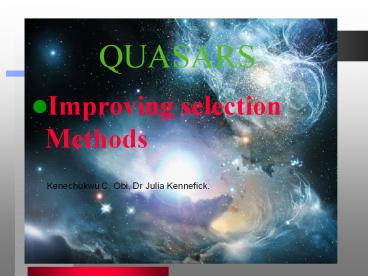QUASAR - PowerPoint PPT Presentation
1 / 15
Title: QUASAR
1
QUASARS
- Improving selection Methods
Kenechukwu C. Obi, Dr Julia Kennefick.
2
What are quasars?
- Quasars are the active nuclei of young galaxies.
- Extremely bright distant
- Powered by accretion of matter into black holes
- Discovered in the 1960s
3
How do astronomers classify Objects?
- Magnitude
- Tells us about brightness of an object
- Dimmer objects have higher magnitudes and vice
versa - Color
- Color is the ratio of the magnitude of flux
coming in from one bandwidth to another
bandwidth. - Useful for comparing objects based upon the
amount of EM waves they emit.
4
How do astronomers classify Objects?
- Morphology
- Shape and size of objects
- Formation of objects
- Spectroscopy
- Chemical Composition of objects
- Redshift Distance
- Temperature
- Information about intervening material
5
How do astronomers identify quasars?
- They make use of graphs called color diagrams
- Color diagrams are x-y plots of two colors, one
against the other - When objects are plotted on this diagrams, they
separate out because of their different
properties - Stars form a neat stellar locus pattern, while
quasars lie on the borders of this locus without
any definite pattern.
6
Here is an example of a color diagram.
- The comet like shape is the stellar locus
- The dots around the edges are the possible quasars
7
What kind of quasars are we interested in?
- In this project we decided to look for quasars of
redshift between 2-3. - Quasars of the given redshift are the most
abundant in the sky. - However, these same quasars have similar optical
colors with most stars, i.e. they are the most
star like in their colors. - Thus they are very hard to distinguish between
stars and these quasars.
8
The graph that shows abundance of quasars based
on their redshift
This graph shows the inefficiency in quasar
detection versus redshift.
9
How do we get around this problems?
- In previous work, color diagrams have been done
with only optical colors. - We will introduce infrared color diagrams,
whereby we plot one optical versus one infrared
color. - We believe that there will be a better
distinction between stars and quasars in the
infrared than in the optical.
10
How do we test our assumption?
- The blue and black squares are known quasars of
redshift 2-3. - J-K is the infrared color while g-J is the
optical color. - Notice that in this plot our candidates (the
small squares) lie roughly in the same region as
the these known quasars. - Note how far away our candidates and known
quasars lie from the stellar locus (black dots).
11
We also did some computer programming.
- Programs were written using Fortran language.
- The aim of these programs are to calculate the
distances of these quasars from us based on their
brightness and redshift. - Another purpose of the program was to calculate
the absolute luminosity of an object based on its
redshift and apparent luminosity. - How bright an object appears depends on its
redshift.
12
We also did some computer programming.
- Two objects may appear equally bright, but this
is deceptive because one might be farther away. - The program takes these facts into consideration
and deduces the correct brightness and distances.
13
- This graph shows the variation of absolute
magnitudes with redshift for a given apparent
magnitude - This graph shows the variation of distances with
redshift for a given apparent magnitude.
14
Future work.
- Our work will be incomplete until we have taken
spectra of our candidates to verify that they are
indeed quasars. - Fortunately, we have been given time in September
at the Kitt Peak National Observatory in Tucson,
Arizona. - We will spend about a week looking at the spectra
of these candidates. - Keep your fingers crossed for us!!!!
15
Acknowledgements.
- I want to take this opportunity to thank the
following institutions and people. - My mentor, Dr. Julia Kennefick, for her kind
instruction. - My Colleagues, Ashley Stewart Shelly Bursick,
for their assistance and support. - The University of Arkansas Space center, and NSF
for funding this program. - And lastly, SDSS, 2MASS, and Kitt Peak for
letting us use their data and equipment.































